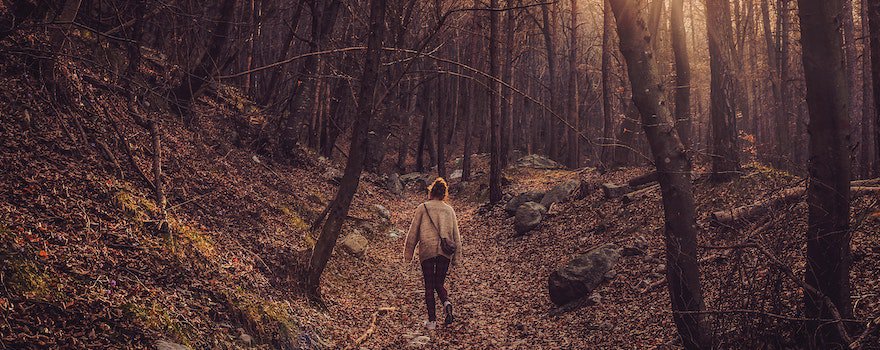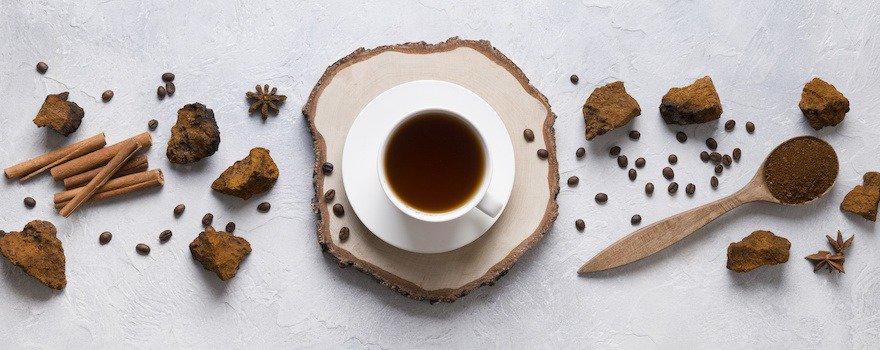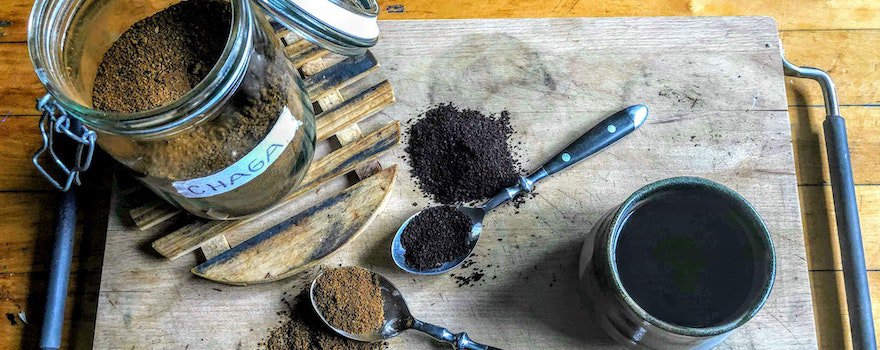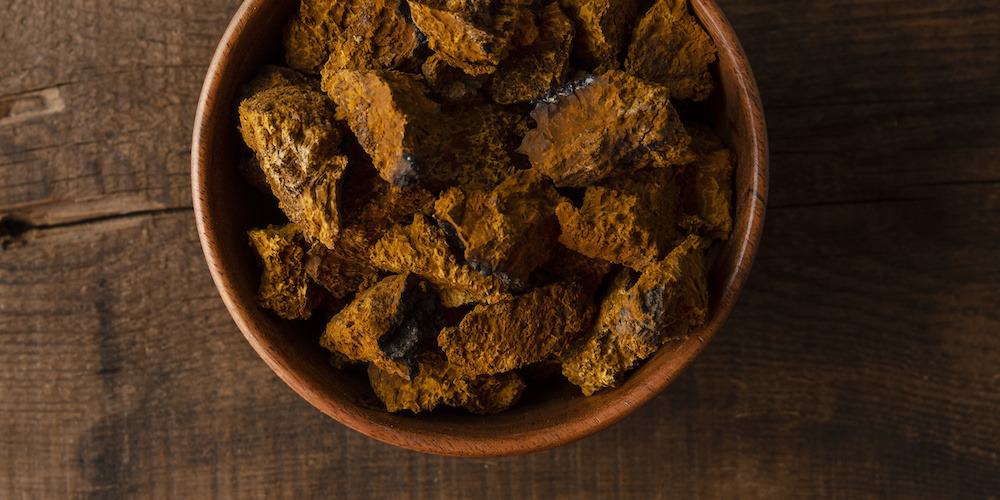BENEFITS OF CHAGA
✓ Strengthens the immune system
✓ Source of antioxidants
✓ Anti-inflammatory
✓ Supports the digestive system
✓ Potentially anti-cancer
What is chaga?
{{{TEMP_MARK_{{{TEMP_MARK_238}}}5}}}
At first glance, chaga is not a particularly attractive mushroom. A parasite of birches on which it grows, it takes on a charred wood appearance. Without a stem, it doesn’t have a defined shape: it follows the movement and irregularities of the tree trunk. In forests, it appears as a brown, rounded, dry, and tough mass, which can reach up to 38 cm in width.
In summer and autumn, chaga grows several meters high, directly on the trunks of living trees. It is found mainly on birches although it can also grow on alders, beeches, and other deciduous trees. To parasitize them, our mushroom exploits unhealed injuries. It then sneaks inside the wood and feeds on the tree’s nutrients.
Chaga can withstand extreme climatic conditions including cold (up to -40°C). That’s why it mainly grows in Russia, Canada, Northern Europe, and in the cold regions of Korea and the United States.
{{{TEMP_MARK_2}}}
Once ground and infused, it helped improve digestion, detoxify the body, and support liver and immune system function. Even today, chaga is an integral part of traditional Russian medicine. However, thanks to extensive research and results achieved, its consumption has gradually become popularized throughout the world, where it is considered as a functional mushroom.
{{{TEMP_MARK_26}}}

Nutritional Composition
- Amino acids
- Vitamins: B1, B2, B3, B5, D, K
- Polysaccharides: beta-glucans
- Phenols and polyphenols: vanillic acid
- Antioxidant compounds: superoxide dismutase, pigments (melanin)
{{{TEMP_MARK_{{{TEMP_MARK_205}}}}}}
{{{TEMP_MARK_{{{TEMP_MARK_{{{TEMP_MARK_238}}}99}}}{{{TEMP_MARK_238}}}}}}
{{{TEMP_MARK_{{{TEMP_MARK_{{{TEMP_MARK_238}}}99}}}2}}}
{{{TEMP_MARK_{{{TEMP_MARK_{{{TEMP_MARK_238}}}99}}}6}}}
{{{TEMP_MARK_{{{TEMP_MARK_{{{TEMP_MARK_238}}}99}}}5}}}
{{{TEMP_MARK_82}}}
{{{TEMP_MARK_7{{{TEMP_MARK_238}}}}}}
{{{TEMP_MARK_62}}}
{{{TEMP_MARK_{{{TEMP_MARK_238}}}{{{TEMP_MARK_{{{TEMP_MARK_238}}}99}}}}}}
{{{TEMP_MARK_{{{TEMP_MARK_{{{TEMP_MARK_238}}}99}}}4}}}
{{{TEMP_MARK_{{{TEMP_MARK_238}}}{{{TEMP_MARK_238}}}{{{TEMP_MARK_238}}}}}}
{{{TEMP_MARK_{{{TEMP_MARK_{{{TEMP_MARK_238}}}99}}}7}}}
{{{TEMP_MARK_{{{TEMP_MARK_{{{TEMP_MARK_238}}}99}}}8}}}
Buy Organic Chaga: My Selection
I recommend organic chaga powder from the French brand Amoseeds. It comes from virgin forests in Estonia, specifically in Valga County.
{{{TEMP_MARK_25}}}
Use our promo code “DARWIN” to get 5% off (valid on all products), and up to 25% off on a group order. By taking advantage of this discount, you also help us keep this blog alive.
{{{TEMP_MARK_92}}}
🛡 Boosts the immune system
{{{TEMP_MARK_2{{{TEMP_MARK_238}}}}}}
These long sugar molecules are known to stimulate the immune system by promoting the development of leukocytes (or white blood cells) including T-lymphocytes, the body’s natural killer cells. The beta-glucans in chaga also activate interleukin-6 (IL-6), a cytokine that promotes the production of antibodies responsible for detecting and neutralizing pathogens.
It also contains numerous vitamins that strengthen the immune system. It is notably an excellent source of vitamin D (calciferol) which boosts defenses and modulates the immune response. Finally, zinc, copper, and selenium are minerals and trace elements in chaga that contribute to the proper functioning of immunity.
{{{TEMP_MARK_{{{TEMP_MARK_238}}}8}}}
🥝 Source of antioxidants
Chaga has a powerful action against free radicals. Indeed, it is composed of 25% antioxidant actives! Among them are pigments like melanin.
{{{TEMP_MARK_{{{TEMP_MARK_238}}}7}}}
Its antioxidant action is also due to the presence of an enzyme: superoxide dismutase. As an essential component of the free radical elimination mechanism, it has a trapping activity and helps fight against aging. This antioxidant enzyme is also found in reishi (Ganoderma lucidum), a Chinese medicinal mushroom.
{{{TEMP_MARK_32}}}
{{{TEMP_MARK_{{{TEMP_MARK_238}}}2}}}
🔥 Anti-inflammatory
{{{TEMP_MARK_24}}}
{{{TEMP_MARK_{{{TEMP_MARK_238}}}3}}}
{{{TEMP_MARK_22}}}
{{{TEMP_MARK_23}}}
♻️ Supports the digestive system
{{{TEMP_MARK_{{{TEMP_MARK_238}}}6}}}
It is also beneficial for the liver and the gallbladder. It particularly promotes the production of bile, essential for digesting food, and protects the liver from lipid oxidation. Furthermore, beta-glucans stimulate good bacteria in the intestines, acting as prebiotics.
This study conducted by various Korean universities on rats shows the hepatoprotective activity of chaga extract.
🔬 Potentially anti-cancer
Chaga is increasingly studied as a potential anti-cancer agent. Indeed, it contains compounds known for their action on unhealthy cells.
By parasitizing birch trees, chaga feeds on the tree’s nutrients such as betulin and betulinic acid. Present in birch sap, these natural substances are cytotoxic, meaning they are toxic to cancer cells.
Moreover, the beta-glucans it contains may help slow the growth of cancer and prevent its spread.
This study conducted by various Korean universities on mice shows how chaga inhibits tumor growth.
{{{TEMP_MARK_3{{{TEMP_MARK_238}}}}}}

How to consume chaga?
In capsules
{{{TEMP_MARK_29}}}
{{{TEMP_MARK_5{{{TEMP_MARK_238}}}}}}
In powder form
{{{TEMP_MARK_4{{{TEMP_MARK_238}}}}}}

The powder can be consumed in infusion or decoction (remember not to boil it), diluted in a drink (hot water, milk, smoothie, latte…) or incorporated into sweet or savory dishes (soups, desserts…).
In mother tincture
{{{TEMP_MARK_{{{TEMP_MARK_238}}}{{{TEMP_MARK_238}}}}}}
The chaga mother tincture is simply diluted in water or fruit juice. However, it has a strong taste that might not appeal to everyone. To soften its woody flavor, you can add honey or maple syrup.
{{{TEMP_MARK_{{{TEMP_MARK_{{{TEMP_MARK_238}}}99}}}0}}}

{{{TEMP_MARK_27}}}
Chaga and Chinese medicinal mushrooms
Chaga pairs well with other medicinal mushrooms like reishi, maitake, agaricus blazei, or shiitake. This mushroom synergy, very rich in beta-glucans, has a powerful effect on the immune system.
{{{TEMP_MARK_{{{TEMP_MARK_238}}}9}}}
Sustainable consumption: choose organic chaga

{{{TEMP_MARK_{{{TEMP_MARK_238}}}}}}
Dosage
{{{TEMP_MARK_52}}}
⏳ Chaga can be taken daily or as a 2-week course to support the immune system, prevent ailments, or relieve inflammation.
💊 In tablets: up to 4 per day for 300 mg capsules.
{{{TEMP_MARK_6{{{TEMP_MARK_238}}}}}}
🧪 In tincture: 20 drops, 1 to 3 times a day.
Contraindications and side effects
Chaga has certain contraindications and its consumption is not recommended for the following people:
- As a precaution, young children, pregnant or breastfeeding women should avoid taking it.
- Because it may contain traces of birch, it is not recommended for people allergic to this tree.
- It has certain drug interactions. Thus, it is not recommended for people on anticoagulants, hypoglycemic and immunosuppressive drugs.
- Since chaga affects insulin levels, people with type 1 diabetes or hypoglycemia should avoid consuming it.
- Chaga consumption is not recommended before surgery or in case of coagulation disorders.
Chaga has few side effects. However, at high doses, it can be toxic to the kidneys and promote the occurrence of kidney stones due to its oxalate content.
If you experience side effects, stop your consumption and consult a doctor.
History, culture and market

{{{TEMP_MARK_{{{TEMP_MARK_{{{TEMP_MARK_238}}}99}}}}}}
{{{TEMP_MARK_{{{TEMP_MARK_238}}}4}}}
{{{TEMP_MARK_28}}}
{{{TEMP_MARK_42}}}
File prepared by Julia Perez and Charlotte Jean
{{{TEMP_MARK_8{{{TEMP_MARK_238}}}}}}
This data has been synthesized and verified for Darwin Nutrition by Laure Fourchaud, Doctor in nutrition physiology.
| {{{TEMP_MARK_{{{TEMP_MARK_238}}}{{{TEMP_MARK_238}}}8}}} | {{{TEMP_MARK_{{{TEMP_MARK_238}}}{{{TEMP_MARK_238}}}9}}} | {{{TEMP_MARK_{{{TEMP_MARK_238}}}20}}} | {{{TEMP_MARK_{{{TEMP_MARK_238}}}{{{TEMP_MARK_238}}}4}}} | {{{TEMP_MARK_{{{TEMP_MARK_238}}}2{{{TEMP_MARK_238}}}}}} |
| {{{TEMP_MARK_{{{TEMP_MARK_238}}}35}}} | {{{TEMP_MARK_{{{TEMP_MARK_238}}}82}}} | {{{TEMP_MARK_{{{TEMP_MARK_238}}}99}}} | {{{TEMP_MARK_{{{TEMP_MARK_238}}}99}}} | {{{TEMP_MARK_{{{TEMP_MARK_238}}}83}}} |
| {{{TEMP_MARK_{{{TEMP_MARK_238}}}45}}} | {{{TEMP_MARK_{{{TEMP_MARK_238}}}54}}} | {{{TEMP_MARK_{{{TEMP_MARK_238}}}84}}} | {{{TEMP_MARK_{{{TEMP_MARK_238}}}{{{TEMP_MARK_205}}}}}} | {{{TEMP_MARK_{{{TEMP_MARK_238}}}56}}} |
| {{{TEMP_MARK_{{{TEMP_MARK_238}}}48}}} | ||||
| {{{TEMP_MARK_{{{TEMP_MARK_238}}}{{{TEMP_MARK_238}}}2}}} | ||||
| {{{TEMP_MARK_{{{TEMP_MARK_238}}}39}}} | {{{TEMP_MARK_{{{TEMP_MARK_238}}}85}}} | {{{TEMP_MARK_{{{TEMP_MARK_238}}}86}}} | {{{TEMP_MARK_{{{TEMP_MARK_238}}}87}}} | {{{TEMP_MARK_{{{TEMP_MARK_238}}}57}}} |
| {{{TEMP_MARK_{{{TEMP_MARK_238}}}40}}} | {{{TEMP_MARK_{{{TEMP_MARK_238}}}58}}} | {{{TEMP_MARK_{{{TEMP_MARK_238}}}59}}} | {{{TEMP_MARK_{{{TEMP_MARK_238}}}83}}} | {{{TEMP_MARK_{{{TEMP_MARK_238}}}60}}} |
| {{{TEMP_MARK_{{{TEMP_MARK_238}}}36}}} | ||||
| {{{TEMP_MARK_{{{TEMP_MARK_238}}}42}}} | {{{TEMP_MARK_{{{TEMP_MARK_238}}}89}}} | {{{TEMP_MARK_{{{TEMP_MARK_238}}}6{{{TEMP_MARK_238}}}}}} | {{{TEMP_MARK_{{{TEMP_MARK_238}}}62}}} | {{{TEMP_MARK_{{{TEMP_MARK_238}}}62}}} |
| {{{TEMP_MARK_{{{TEMP_MARK_238}}}{{{TEMP_MARK_238}}}5}}} | ||||
| {{{TEMP_MARK_{{{TEMP_MARK_238}}}4{{{TEMP_MARK_238}}}}}} | {{{TEMP_MARK_20{{{TEMP_MARK_238}}}}}} | {{{TEMP_MARK_20{{{TEMP_MARK_238}}}}}} | {{{TEMP_MARK_20{{{TEMP_MARK_238}}}}}} | {{{TEMP_MARK_20{{{TEMP_MARK_238}}}}}} |
| {{{TEMP_MARK_{{{TEMP_MARK_238}}}47}}} | {{{TEMP_MARK_{{{TEMP_MARK_238}}}64}}} | {{{TEMP_MARK_{{{TEMP_MARK_238}}}65}}} | {{{TEMP_MARK_{{{TEMP_MARK_238}}}52}}} | {{{TEMP_MARK_{{{TEMP_MARK_238}}}66}}} |
| {{{TEMP_MARK_{{{TEMP_MARK_238}}}43}}} | {{{TEMP_MARK_{{{TEMP_MARK_238}}}66}}} | {{{TEMP_MARK_238}}} | {{{TEMP_MARK_{{{TEMP_MARK_238}}}53}}} | {{{TEMP_MARK_{{{TEMP_MARK_238}}}68}}} |
| {{{TEMP_MARK_{{{TEMP_MARK_238}}}30}}} | {{{TEMP_MARK_{{{TEMP_MARK_238}}}90}}} | {{{TEMP_MARK_{{{TEMP_MARK_238}}}69}}} | {{{TEMP_MARK_{{{TEMP_MARK_238}}}70}}} | {{{TEMP_MARK_{{{TEMP_MARK_238}}}64}}} |
| {{{TEMP_MARK_{{{TEMP_MARK_238}}}3{{{TEMP_MARK_238}}}}}} | {{{TEMP_MARK_{{{TEMP_MARK_238}}}66}}} | 2 | {{{TEMP_MARK_{{{TEMP_MARK_238}}}9{{{TEMP_MARK_238}}}}}} | {{{TEMP_MARK_{{{TEMP_MARK_238}}}73}}} |
| {{{TEMP_MARK_{{{TEMP_MARK_238}}}37}}} | {{{TEMP_MARK_{{{TEMP_MARK_238}}}92}}} | |||
| {{{TEMP_MARK_{{{TEMP_MARK_238}}}38}}} | {{{TEMP_MARK_205}}} | {{{TEMP_MARK_{{{TEMP_MARK_238}}}74}}} | {{{TEMP_MARK_{{{TEMP_MARK_238}}}74}}} | {{{TEMP_MARK_{{{TEMP_MARK_238}}}76}}} |
| {{{TEMP_MARK_{{{TEMP_MARK_238}}}44}}} | {{{TEMP_MARK_{{{TEMP_MARK_238}}}77}}} | {{{TEMP_MARK_{{{TEMP_MARK_238}}}66}}} | {{{TEMP_MARK_{{{TEMP_MARK_238}}}66}}} | |
| {{{TEMP_MARK_{{{TEMP_MARK_238}}}49}}} | {{{TEMP_MARK_20{{{TEMP_MARK_238}}}}}} | {{{TEMP_MARK_20{{{TEMP_MARK_238}}}}}} | {{{TEMP_MARK_20{{{TEMP_MARK_238}}}}}} | {{{TEMP_MARK_20{{{TEMP_MARK_238}}}}}} |
| {{{TEMP_MARK_{{{TEMP_MARK_238}}}46}}} | {{{TEMP_MARK_{{{TEMP_MARK_238}}}93}}} | {{{TEMP_MARK_238}}} | {{{TEMP_MARK_{{{TEMP_MARK_238}}}66}}} | {{{TEMP_MARK_{{{TEMP_MARK_238}}}68}}} |
| {{{TEMP_MARK_{{{TEMP_MARK_238}}}{{{TEMP_MARK_238}}}6}}} | ||||
| {{{TEMP_MARK_{{{TEMP_MARK_238}}}32}}} | {{{TEMP_MARK_20{{{TEMP_MARK_238}}}}}} | {{{TEMP_MARK_20{{{TEMP_MARK_238}}}}}} | {{{TEMP_MARK_20{{{TEMP_MARK_238}}}}}} | {{{TEMP_MARK_20{{{TEMP_MARK_238}}}}}} |
| {{{TEMP_MARK_{{{TEMP_MARK_238}}}33}}} | {{{TEMP_MARK_20{{{TEMP_MARK_238}}}}}} | {{{TEMP_MARK_20{{{TEMP_MARK_238}}}}}} | {{{TEMP_MARK_20{{{TEMP_MARK_238}}}}}} | {{{TEMP_MARK_20{{{TEMP_MARK_238}}}}}} |
| {{{TEMP_MARK_{{{TEMP_MARK_238}}}23}}} | {{{TEMP_MARK_{{{TEMP_MARK_238}}}92}}} | |||
| {{{TEMP_MARK_{{{TEMP_MARK_238}}}34}}} | {{{TEMP_MARK_20{{{TEMP_MARK_238}}}}}} | {{{TEMP_MARK_20{{{TEMP_MARK_238}}}}}} | {{{TEMP_MARK_20{{{TEMP_MARK_238}}}}}} | {{{TEMP_MARK_20{{{TEMP_MARK_238}}}}}} |
| {{{TEMP_MARK_{{{TEMP_MARK_238}}}24}}} | {{{TEMP_MARK_{{{TEMP_MARK_238}}}92}}} | |||
| {{{TEMP_MARK_{{{TEMP_MARK_238}}}25}}} | {{{TEMP_MARK_{{{TEMP_MARK_238}}}92}}} | |||
| {{{TEMP_MARK_{{{TEMP_MARK_238}}}26}}} | {{{TEMP_MARK_{{{TEMP_MARK_238}}}92}}} | |||
| {{{TEMP_MARK_{{{TEMP_MARK_238}}}27}}} | {{{TEMP_MARK_{{{TEMP_MARK_238}}}92}}} | |||
| {{{TEMP_MARK_{{{TEMP_MARK_238}}}28}}} | {{{TEMP_MARK_20{{{TEMP_MARK_238}}}}}} | {{{TEMP_MARK_20{{{TEMP_MARK_238}}}}}} | {{{TEMP_MARK_20{{{TEMP_MARK_238}}}}}} | {{{TEMP_MARK_20{{{TEMP_MARK_238}}}}}} |
| {{{TEMP_MARK_{{{TEMP_MARK_238}}}{{{TEMP_MARK_238}}}3}}} | {{{TEMP_MARK_20{{{TEMP_MARK_238}}}}}} | {{{TEMP_MARK_20{{{TEMP_MARK_238}}}}}} | {{{TEMP_MARK_20{{{TEMP_MARK_238}}}}}} | {{{TEMP_MARK_20{{{TEMP_MARK_238}}}}}} |
| {{{TEMP_MARK_{{{TEMP_MARK_238}}}22}}} | {{{TEMP_MARK_20{{{TEMP_MARK_238}}}}}} | {{{TEMP_MARK_20{{{TEMP_MARK_238}}}}}} | {{{TEMP_MARK_20{{{TEMP_MARK_238}}}}}} | {{{TEMP_MARK_20{{{TEMP_MARK_238}}}}}} |
| {{{TEMP_MARK_{{{TEMP_MARK_238}}}29}}} | {{{TEMP_MARK_20{{{TEMP_MARK_238}}}}}} | {{{TEMP_MARK_20{{{TEMP_MARK_238}}}}}} | {{{TEMP_MARK_20{{{TEMP_MARK_238}}}}}} | {{{TEMP_MARK_20{{{TEMP_MARK_238}}}}}} |
{{{TEMP_MARK_72}}}
Antioxidants: dismutase
Other compounds: germanium, silicon and selenium (minerals), vanillic acid (polyphenols), triterpenes, tannins, lectins, polysaccharides (carbohydrates), sterols
Sources and scientific studies
Gery A, Dubreule C, André V, Rioult JP, Bouchart V, Heutte N, Eldin de Pécoulas P, Krivomaz T, Garon D, 2018. Chaga (Inonotus obliquus), a Future Potential Medicinal Fungus in Oncology? A Chemical Study and a Comparison of the Cytotoxicity Against Human Lung Adenocarcinoma Cells (A549) and Human Bronchial Epithelial Cells (BEAS-2B).
Harikrishnan R, Balasundaram C, Heo MS, 2012. Inonotus obliquus containing diet enhances the innate immune mechanism and disease resistance in olive flounder Paralichythys olivaceus against Uronema marinum.
Yong Cuia, Dong-Seok Kimab, Kyoung-Chan Parka, 2003. Antioxidant effect of Inonotus obliquus.
Park YM, Won JH, Kim YH, Choi JW, Park HJ, Lee KT, 2005. In vivo and in vitro anti-inflammatory and anti-nociceptive effects of the methanol extract of Inonotus obliquus.
Hong KB, Noh DO, Park Y, Suh HJ, 2015. Hepatoprotective Activity of Water Extracts from Chaga Medicinal Mushroom, Inonotus obliquus (Higher Basidiomycetes) Against Tert-Butyl Hydroperoxide-Induced Oxidative Liver Injury in Primary Cultured Rat Hepatocytes.
Mi Ja Chung, Cha-Kwon Chung, Yoonhwa Jeong, and Seung-Shi Ham, 2010. Anticancer activity of subfractions containing pure compounds of Chaga mushroom (Inonotus obliquus) extract in human cancer cells and in Balbc/c mice bearing Sarcoma-180 cells.
Lemieszek MK, Langner E, Kaczor J, Kandefer-Szerszeń M, Sanecka B, Mazurkiewicz W, Rzeski W, 2011. Anticancer effects of fraction isolated from fruiting bodies of Chaga medicinal mushroom, Inonotus obliquus (Pers.:Fr.) Pilát (Aphyllophoromycetideae): in vitro studies.




